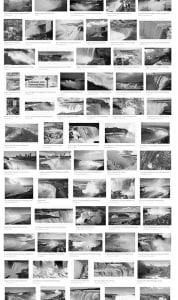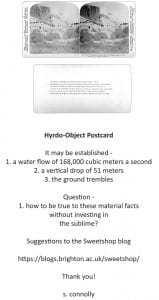Hydro-Object
Three posters and text by Stephen Connolly
The images you see in the window are part of a project in its early stages about a site – Niagara Falls on the US/Canadian border. I know this site quite well; as a project I need to have a strategy informing how a subject may be seen. This is a set of guidelines – or exceptionally, rules – within which the film will be made. This structure leaves room for playfulness in a journey to represent a subject. The result is a carefully calibrated composite of order and chaos.
These images represent two modes of image acquisition and viewing –
– a discrete choice of a singular image – drawn from the archive of image types and modes of viewing them – in this case, a stereoscopic view of the Falls;
– the second is a channel selection – an online torrent of indexed images, sorted by invisible aggregators, supplied through the labour of visualising the Falls;
Both image modes inspire narratives – private and public – and versions of the sublime – in previous and contemporary ways. The second stream of images shares material affinities with the Falls – if we frame the images as digital material, and as we call up their page they hurtle over the precipice and into the index; intermixing with every other image taken in the boiling, liquid screen.
No doubt there are further ways to frame and interpret these images and their content. My question is genuine in this regard – for I am seeking other means of representing our surroundings. As Timothy Morton describes in his Hyperobjects–
Consider raindrops: you can feel them on your head—but you can’t perceive the actual raindrop in itself. You only ever perceive your particular, anthropomorphic translation of the raindrops. … The gap between phenomenon and thing yawns open, disturbing my sense of presence and being in the world. … things are themselves, but we can’t point to them directly.
Timothy Morton 2013 pp17-18
I’m proposing Niagara Falls as one of those places where this gap can be explored – if we remain fully aware of the tools we are using and their interaction with the conceptual framework of the investigation. We may find unusual axes of interest intersecting and opening up new fields for inquiry.
Thanks for reading and looking forward to any responses and observations!
Steve
Thanks to-
Janice McLaren
Peter McLaren
Richard McLaren
Spatial Cinema Screening at Depot, Lewes 1st July 8pm
Stephen Connolly in conversation with Prof Tony Dowmunt





Thanks for posting.
you can check:Online Sweet Shop
Your blog was really very helpful and informative for me, Thank you. you can check Order Sweets Online in India
Thank you for your kind words and for finding our content helpful! you can check Order Sweets Online in India